Try this savory hot dry noodle dish with a rich sauce and pickles on top for an authentic Chinese street food meal! {Vegan-Adaptable}
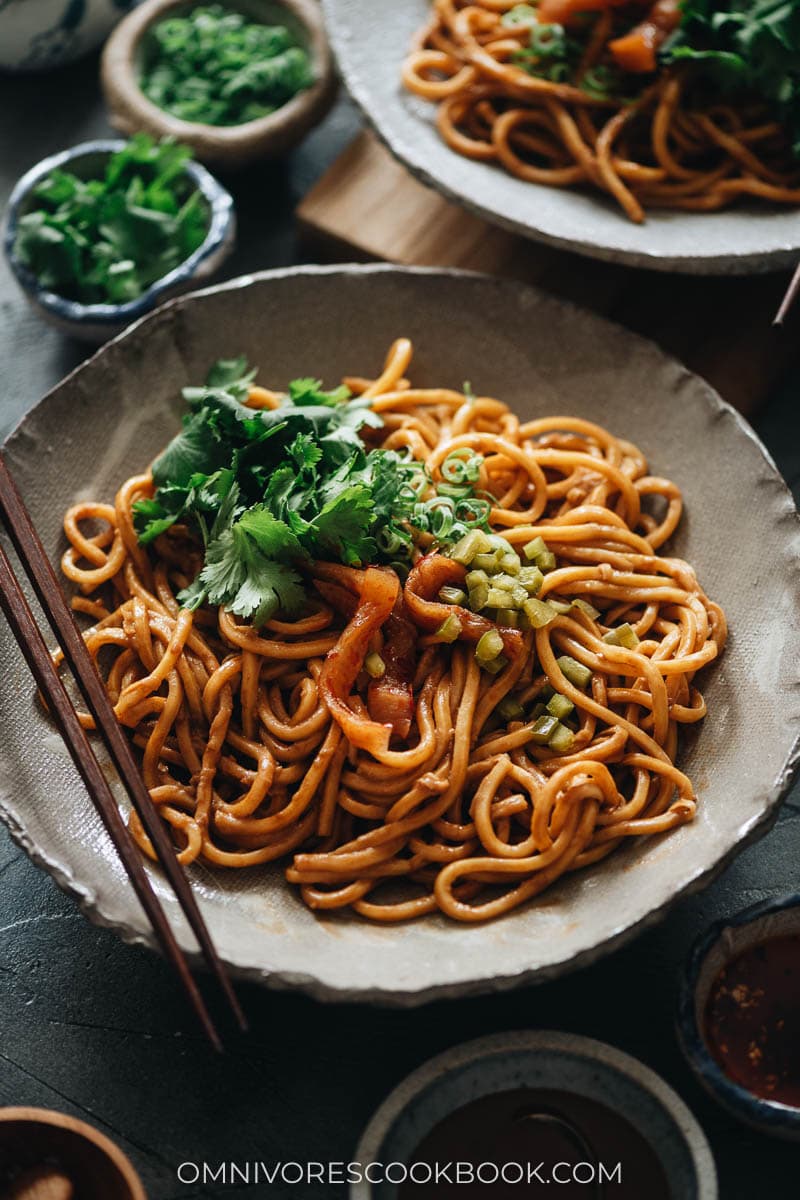
Hot dry noodles, or ‘re gan mian’ (热干面), is a classic Chinese summer dish that’s often eaten for breakfast in Hubei province though it’s very popular throughout China. It’s also one of the 10 most famous noodle dishes in China.
The vendors are out at dawn serving up heaping portions of this historic noodle dish, quite like the way they serve Dan Dan Noodles in Sichuan. Once you order it, the vendor will assemble your bowl using thick noodles, a sesame-paste-based sauce, aromatic broth, and assorted pickles. It is so simple, yet very bold and satisfying in flavor.
I want to introduce this dish to you because it’s a perfect dish for the summer. It’s funny that even though this dish is called hot dry noodles, it is usually served cold and it is very saucy. Another great thing about these hot dry noodles is that they’re an outstanding meal prep dish. You can make a big batch of the sauce to use later. Simply assemble the noodles before you serve and it’s a done deal. Enjoy them hot or cold, anyway that you like!
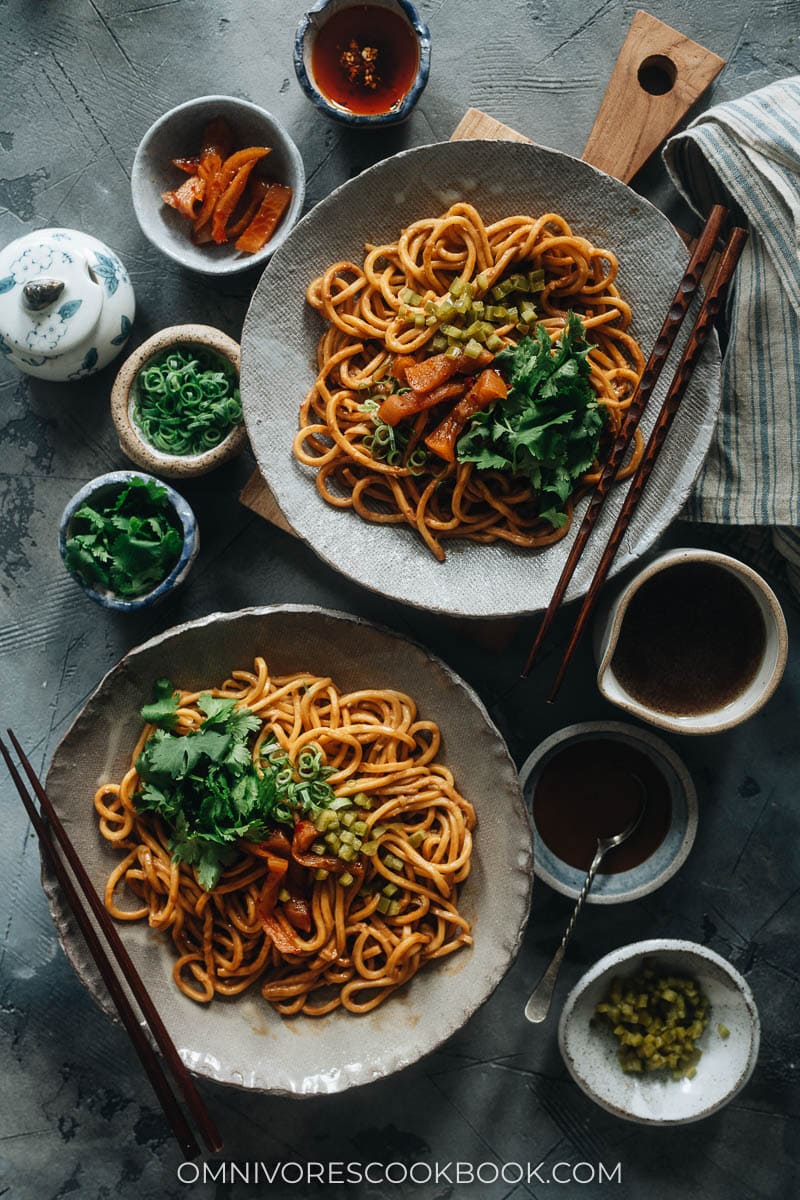
Why this recipe
If you travel to China, you’ll find two distinct and popular versions of hot dry noodles. There’s one that is made with a simple sesame sauce. Then there’s another that has a wonderfully savory broth on top of that sesame sauce. For my hot dry noodles, I went with the brothy style because it is quite easy to make and it adds a wonderful umami to the dish.
Don’t worry about the list of ingredients for the broth of these hot dry noodles. I know it looks long, but it’s all pantry staples you likely have on hand and it is so easy to put together. We often refer to this as a ‘master sauce’ or ‘Chinese thousand-year broth’ because it is the same sauce base you see in so many traditional dishes in Chinese cuisine.
I like the broth version best because it adds tons of fragrance, plus it keeps the hot dry noodles nice and saucy. Without the broth, the noodles become really dry once they’re chilled.
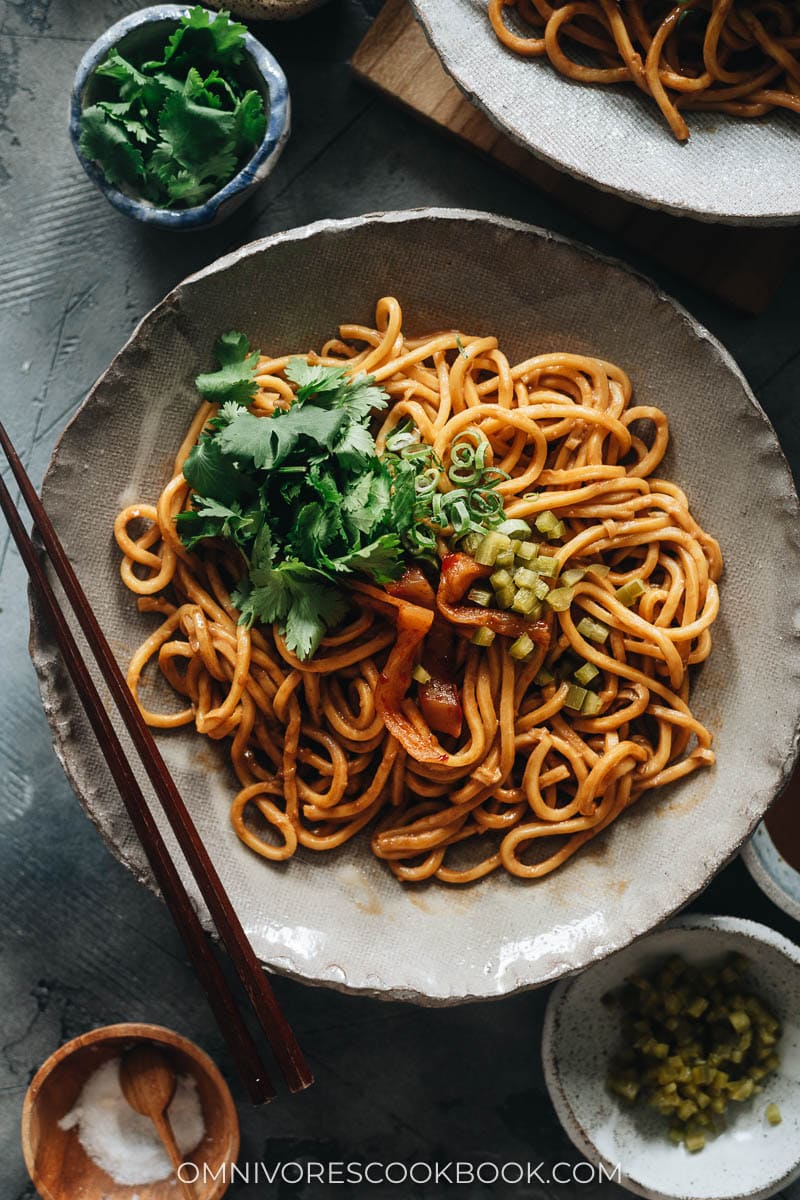
Ingredients
What type of noodles to use
Authentic hot dry noodles always use chewy alkaline noodles. The best kind to use in this recipe is the pre-cooked type. It’s called You Mian (油面) in Chinese and simply labeled “Cooked Noodle” in English. In a Chinese market, you might find them in the refrigerated section and they’re ready to be used right out of the package. More often though, you’ll actually find them in the freezer section. The noodle texture may be a bit off once thawed. So I usually bring a pot of water to a boil and quickly rinse the thawed noodles before using them, just to bring back their texture.

If you cannot find the “Cooked Noodle”, ramen noodles are a good alternative. They are alkaline noodles in a thinner form. Whole Foods even sells fresh ramen these days, so you can skip a run to the Asian market.
If you cannot find either, you can simply use a wheat noodle or use the thin form of my homemade hand pulled noodles.
Pickles
In the traditional method of serving hot dry noodles, it comes with Chinese pickled radish, pickled mustard stem, and pickled sour green beans.
In the picture below, I’ve showed:
- Sui Mi Ya Cai (left): you might have it on hand if you’ve made Dan Dan noodles from my blog. It’s not the traditional pickle to use in this dish but you can use a small spoon of it to boost the flavor.
- Spicy pickled radish (middle): it’s my favorite. These radish pickles are salty, sweet, spicy, with a nice crunch. Traditionally used in hot dry noodles, I highly recommend them.
- Zha Cai (right): a common mustard stem pickle. It’s salty and sweet. Also not used in this dish traditionally but it might be easier to find.
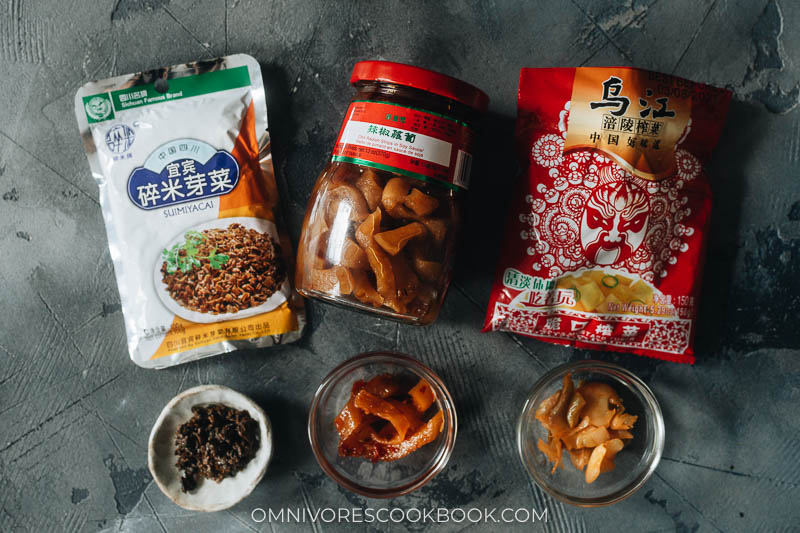
If you have a Chinese market near you, you can easily find these ingredients. But if not, you can always use your own favorite pickles. Or follow my pickle recipes to make quick pickles of your own. I love these! I have pickled cucumbers, pickled cabbage, and pickled peppers and they are each wonderful with this hot dry noodles recipe.
Sauce
The sesame-based sauce is packed with flavor. To make it a bit more fragrant, we used hot water to make a garlic-infused water to release the garlicky fragrance without tasting the raw, pungent flavor. The garlic water also thins out the sauce a bit without diluting its flavor.
Chinese sesame paste is the best way to go. But if you cannot find it, you can use unsweetened natural peanut butter.
I think tahini would create a great flavor too, though it will be quite different from the original.
Cooking process
Prepare the master sauce
For this dish, you only need to cook the master sauce and prepare the noodles.
To make the master sauce
- Saute the aromatics
- Boil with broth of your choice
- Strain and it’s ready to use
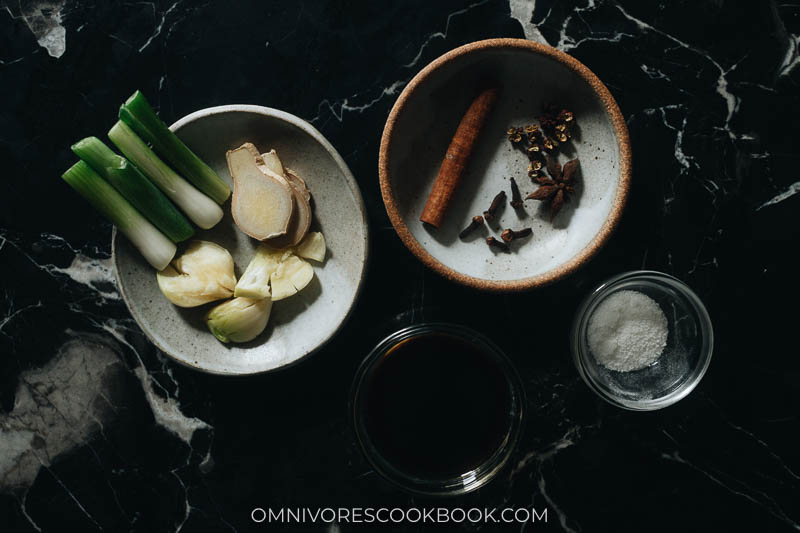
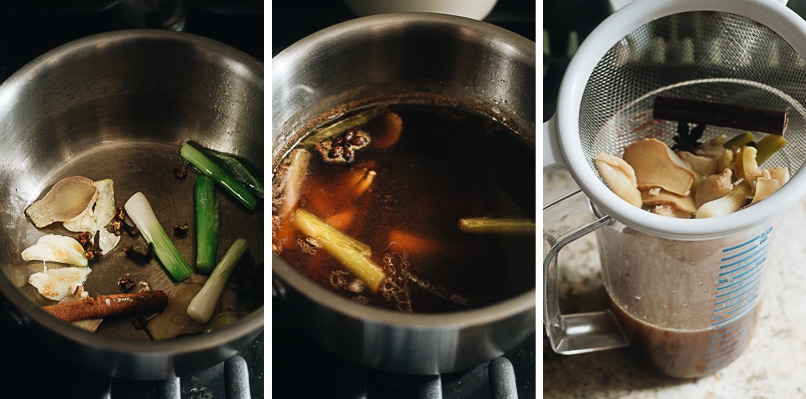
Mixing the sesame sauce
- Mix the garlic with hot water to infuse the aroma, then add it to the sesame paste
- Add the rest of the seasonings to make the super rich and nutty sauce
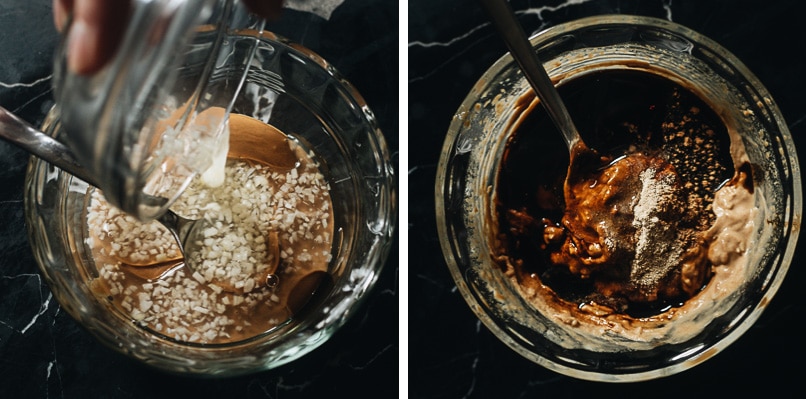
Cook the noodles
If you use the cooked alkaline noodles, you only need to quickly rinse the noodles in hot water to bring back their texture.
If you use other noodles, you will need to boil the noodles according to the package instructions.
Once you’re done preparing the noodles, the master sauce, and the sesame sauce, all you need to do is mix them together and top them with your favorite pickles!
It’s super simple.
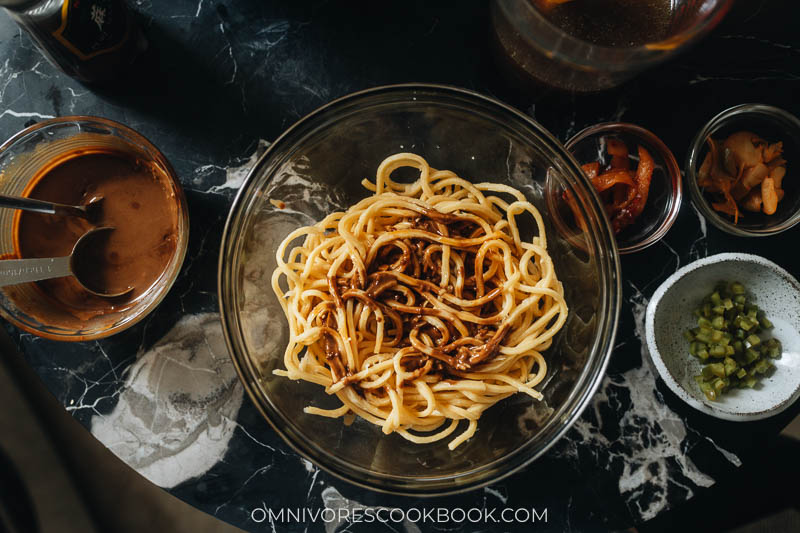
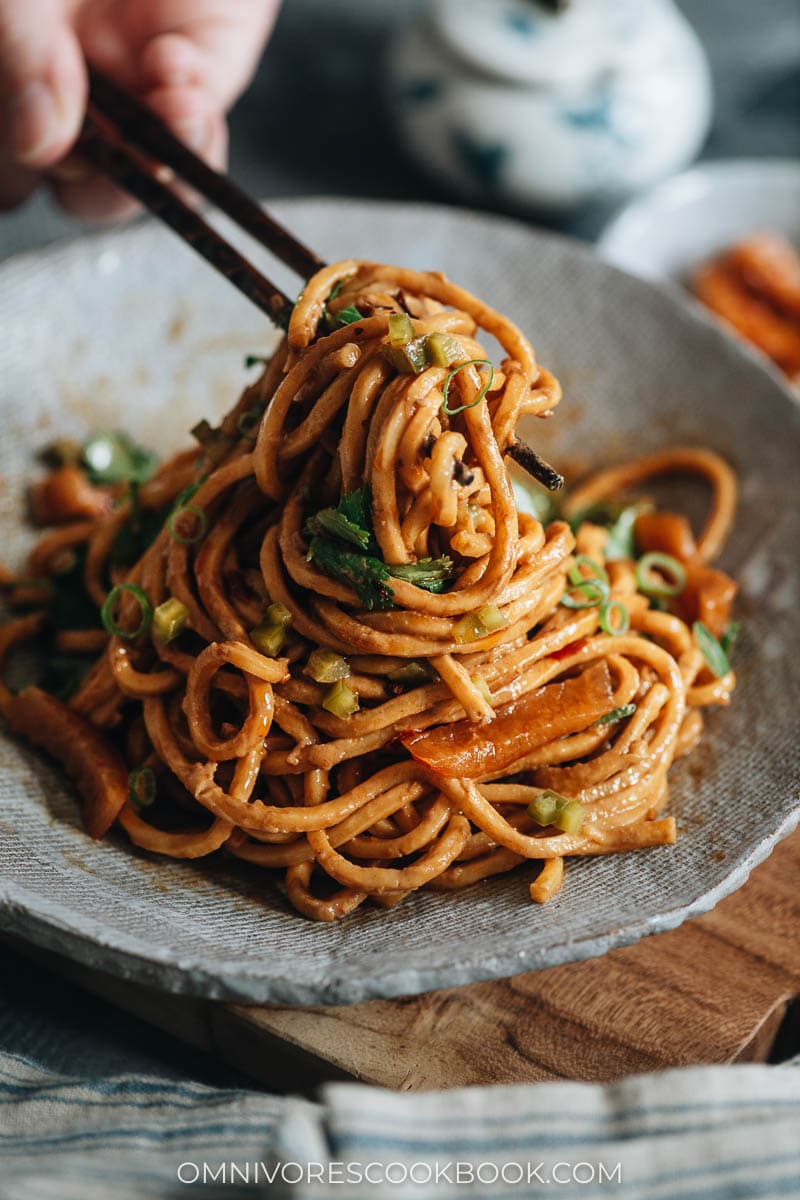
Afterthoughts
I know this recipe might look intimidating. But once you try it, you’ll find it surprisingly easy to put together. The traditional version does require many special ingredients. But the best part is, you can get around that by using more common ingredients and still create a delicious bowl of noodles.
Besides the pickles, you can top other ingredients such as cooked meat and blanched veggies to make a more filling meal.
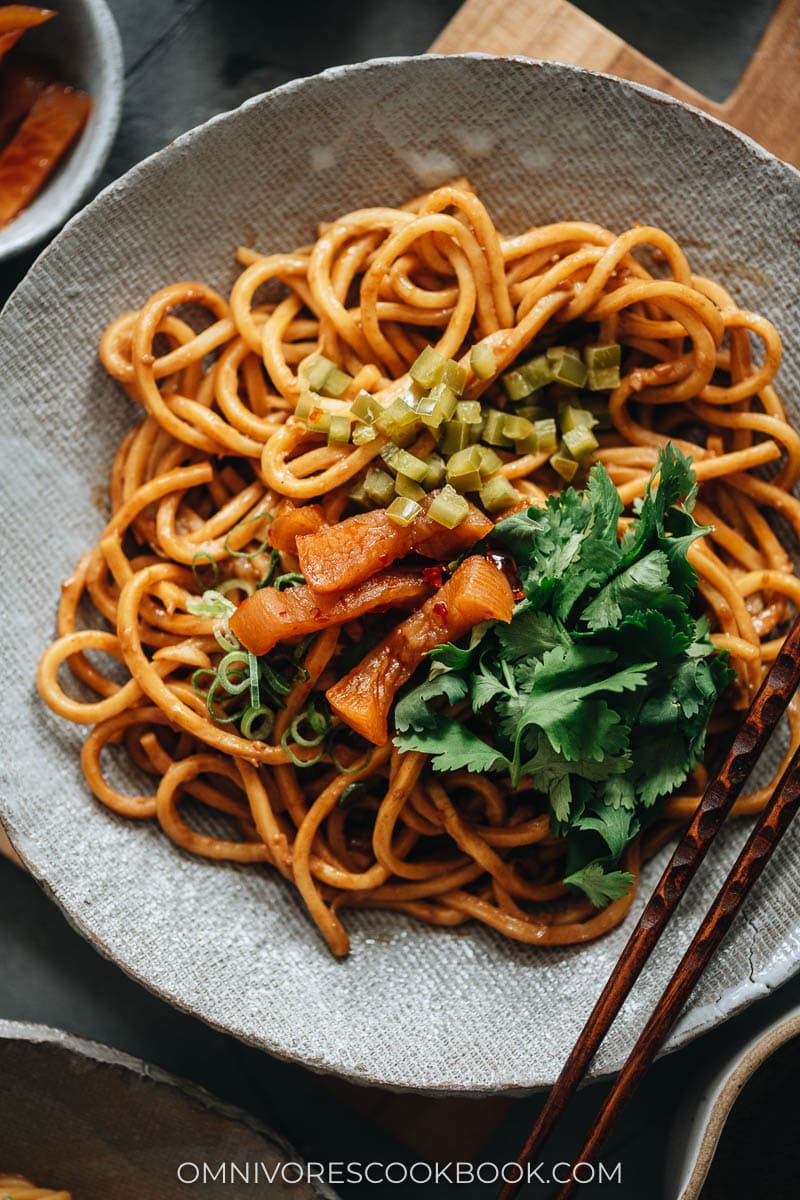
Want to learn more about Chinese Cooking? Sign up my newsletter to receive the 5-Day Chinese Cooking Crash Course and recipe update!

Hot Dry Noodles (热干面)
Ingredients
- 300 g (10 oz) fresh alkaline noodles , cooked or uncooked (or regular wheat noodles) (*Footnote 1)
- 1 tablespoon sesame oil
Broth (*Footnote 2)
- 1 teaspoon vegetable oil
- 2 green onions just the whites (greens reserved)
- 2 slices ginger
- 2 cloves garlic , lightly smashed
- 1 star anise
- 5 cloves
- 1 cinnamon stick
- 1/4 teaspoon Sichuan peppercorns
- 2 tablespoons shaoxing wine (or dry sherry)
- 1 tablespoon light soy sauce
- 1 teaspoon sugar
- 2 cups beef stock (chicken stock, or vegetable stock)
Garlic Water:
- 2 cloves garlic , minced
- 3 tablespoons hot water
Sauce:
- 3 tablespoons Chinese sesame paste (or unsweetened natural peanut butter)
- 1 teaspoon sesame oil
- 2 teaspoons light soy sauce
- 1 teaspoon dark soy sauce
- 1 1/2 1/2 teaspoons Chinkiang vinegar
- 1 teaspoon sugar
- 1/8 teaspoon white pepper powder
- 1/8 teaspoon five spice powder
Toppings:
- 2 to 4 tablespoons homemade chili oil (Optional)
- Reserved green onion , sliced
- 1/4 cup pickled radish (or mustard greens or your favorite pickles)
- Cilantro leaves
Instructions
- Garlic water: Combine the 2 cloves of minced garlic and 3 tablespoons of hot water in a small bowl. Set aside.
- Master sauce: In a small pot, heat the vegetable oil over medium heat and add the green onion, ginger, and garlic. Saute until fragrant, about 1 minute. Add the star anise, cloves, cinnamon, and fennel seeds and cook for another 30 seconds. Add the Shaoxing wine, soy sauce, sugar, and broth. Bring to a boil, then reduce to a simmer. Cook for 10 to 15 minutes. Strain and discard the aromatics and spices.
- Sesame sauce: Slowly incorporate the garlic water into the sesame paste until smooth. Then add the remaining sauce ingredients.
- Prepare noodles: Bring a pot of water to a boil. (1) If using the Cooked Noodle (You Mian), quickly rinse the noodles in the hot water to revive its texture and drain. (2) If using uncooked fresh ramen noodles, drizzle the sesame oil over the noodles and toss gently. Add the noodles to the boiling water and cook until al dente. (3) If using regular dried noodles, boil according to the instructions. Once done, drain the noodles and divide between 2 bowls.
- Assemble: Add 2 tablespoons of the broth, 2 tablespoons of the sesame sauce, and 1 tablespoon of chili oil (if using) to each bowl. Garnish with the green onion, preserved vegetables of your choice, and cilantro leaves.
- Toss everything together, then adjust the seasoning to taste by adding more sauce or broth. Enjoy hot or cold!
Storage
- The noodles, sauce, and broth can be prepared ahead of time and stored in the fridge separately for up to 3 days. Assemble them whenever you plan to serve.
Notes
- The correct alkaline noodles are usually labeled as “Cooked Noodle”. See the blog post above for the package picture. You can also use fresh uncooked ramen noodles, which are thinner than the Chinese alkaline noodles. Regular dried wheat noodles work too if you cannot find alkaline noodles. The texture of the noodles will be different but the taste will still be good.
- The recipe generates more broth than you need in this recipe. You can fridge or freeze them for future use.
Nutrition
If you give this recipe a try, let us know! Leave a comment, rate it (once you’ve tried it), and take a picture and tag it @omnivorescookbook on Instagram! I’d love to see what you come up with.













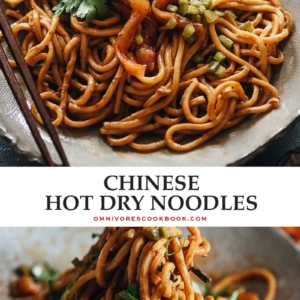
Fair amount of work but the result is excellent., Maggie.
Fennel seeds are not in the ingredients list. I used about half a teaspoon.
Do you think that chili garlic sauce can substitute for chili oil in this recipe?
Thank you
Fair amount of work but the result is excellent, Maggie.
Fennel seeds are not in the ingredients list. I used about half a teaspoon.
Do you think that chili garlic sauce can substitute for chili oil in this recipe?
Thank you
Glad to hear you like the recipe! Yeah I think it’s totally OK to use the chili garlic sauce instead of chili oil.
I’ll check my note and add back the fennel seeds but I think 1/2 teaspoon sounds about right.
Great recipe, very delicious! I added crispy shallots and cucumber pickle.